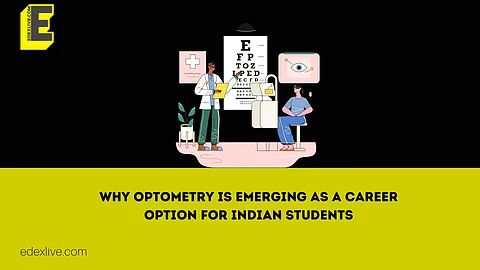

In a country where professional success has long been equated with engineering or medicine, optometry is being seen quietly and steadily as a practical and socially relevant alternative. It appeals to students who want to be in healthcare but may not have the resources or inclination to commit to long years of medical education.
Optometry plays a key role in preserving and improving vision. Optometrists are trained to examine the eyes, diagnose vision problems, prescribe corrective lenses, and detect early signs of eye diseases. In many cases, they are the first point of contact in the eye care system, providing essential preventive care and referring patients to ophthalmologists when more specialised treatment is needed.
As India grapples with a rising burden of vision-related issues — driven by an ageing population, increased screen exposure, and lifestyle changes — the importance of optometry is coming into sharper focus. India is currently facing a significant shortage of trained optometrists, with an estimated need for over 40,000 professionals, as per the World Health Organization (WHO).
This gap points to an urgent need to expand and strengthen optometric education and services nationwide.
Optometry as a career: A profession on the rise
Vision care has traditionally been undervalued in India’s healthcare narrative. Yet, untreated refractive errors, cataracts, and preventable forms of blindness affect millions across the country, often with a silent impact on productivity, education, and quality of life. These issues often go undetected until they cause a significant impact on quality of life — particularly in rural and economically disadvantaged regions.
Trained optometrists play a crucial role in detecting such eye conditions. Their work not only supports ophthalmologists but also helps to reduce the load on tertiary care systems. As eye care becomes more integrated into public health outreach, optometry is receiving the attention it has long needed.
Internationally, optometry professionals are increasingly in demand across Asia, Africa, and the Middle East. Opportunities in the U.S. and Europe are also growing, with entry-level salaries averaging around $120,000 annually. Indian graduates with strong clinical training and adaptability are well positioned to explore these global job opportunities.
Role of education access: Education migration and regional gaps
One more aspect of optometry’s growing popularity is where the interest is coming from. There has been a noticeable rise in students from remote or underserved regions, particularly Northeastern states like Manipur, Assam, and Meghalaya, who are actively seeking out professional training in optometry.
This isn’t just about career preference — it highlights broader disparities in access to quality eye care. As per a study published in Delhi Journal of Optometry, the gap between eye care services needed and those available has only widened in North-east states like Assam over the past four decades. Around 18.8% of Indians suffering from cataract-related blindness are from Assam.
Overall, 40% of the state’s population faces some form of ophthalmic issue. Hence, such regions are heavy in demand of quality eye care professionals.
In many parts of India, there is a shortage of specialised educational institutions that offer applied clinical training in allied health fields. As a result, students who are serious about pursuing careers in areas like optometry often find themselves having to move far from home to receive the necessary education.
This educational migration is a window into broader inequities in healthcare training infrastructure — and, simultaneously, into how regional aspirations are reshaping India’s healthcare landscape.
What Optometry offers that students are responding to
The structure of optometry programmes — typically a three-year academic course followed by a year-long clinical internship — provides a relatively quicker route to employability, without compromising on depth. After completing their training, optometry graduates have multiple career options. They may join optical chains, work in hospitals and specialty clinics, contribute to public health programmes, or pursue further education.
Some also choose to set up independent practices, bringing affordable and accessible eye care to areas that need it. Over time, many graduates develop expertise in subspecialties like low vision care, pediatric optometry, or contact lens fitting.
A few go into research or teaching. In our experience, a number of students return to their home states after graduation, where they feel their skills can have a direct and meaningful impact.
The Future of Optometry in India
The future of optometry will likely be shaped by a mix of continuity and change. The core clinical responsibilities will remain, but newer areas — such as low-vision rehabilitation, geriatric vision care, and tech-enabled diagnostics — are beginning to emerge. In a digitally expanding healthcare environment, optometrists who are adaptable and continue to learn will be better positioned to contribute meaningfully.
For students in India, especially those from underrepresented regions, optometry represents a career that intersects skill, service, and sustainability. It is not a fast track to status or wealth — but it offers something many students today are looking for: a role that is grounded in public need, professionally rewarding, and aligned with their own values and lived realities.
(Dr Savitha Arun is the Principal of Nethradhama School of Optometry and Consultant – Anterior Segment & Electrophysiology at Nethradhama Super Speciality Eye Hospital, Bengaluru. Views expressed are her own)
